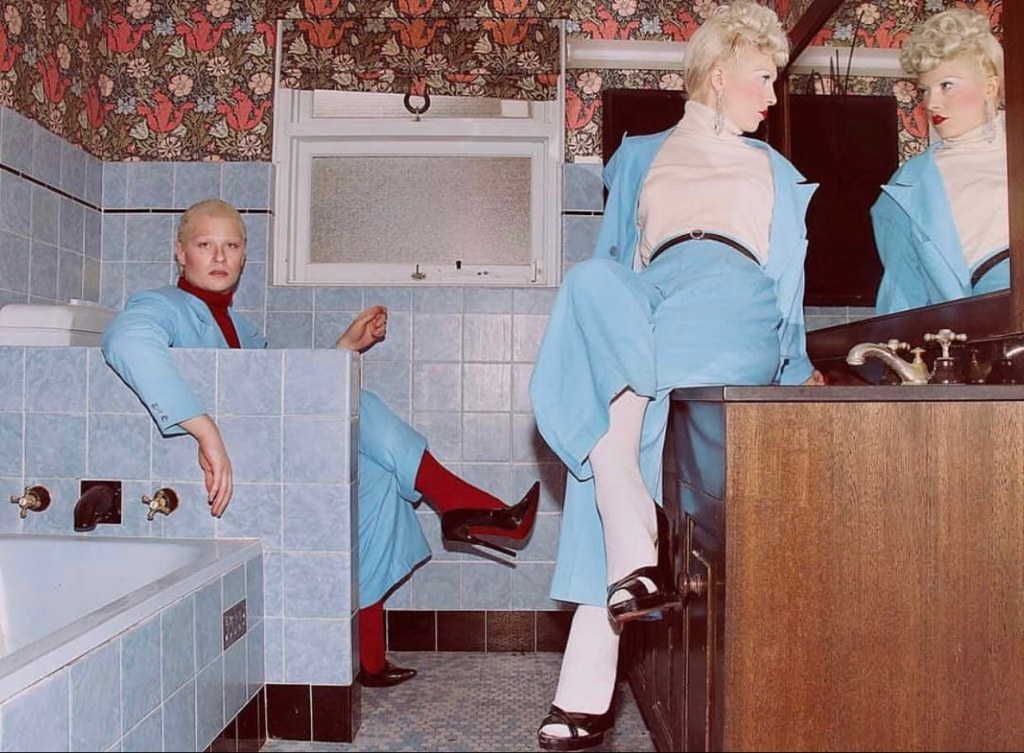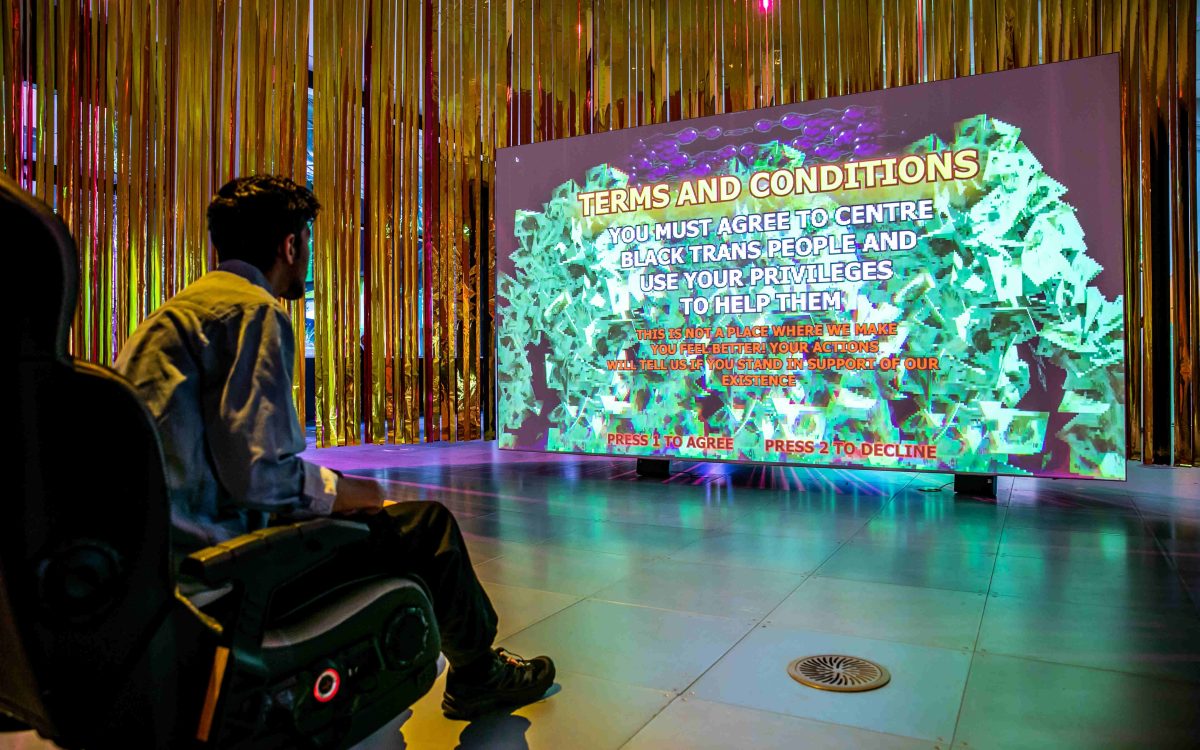Australia’s state of New South Wales is currently in the midst of Sydney WorldPride, a queer activation celebrating creatives, activists, change makers and the community at large.
While in the state of Victoria, Daylesford will host Australia’s largest regional LGBTQIA+ Festival, Chillout Festival from 9-13 March, and last year a major exhibition at the National Gallery of Victoria, QUEER: Stories from the NGV Collection presented the prominent role queer culture has played from past to present.
Increasingly queer identities are being openly acknowledged and celebrated in the arts and, in many instances, young people are forging the way ahead on gender diversity. An exhibition that explores what that looks like is, BREAK THE BINARIES – the third exhibition of its kind presented by Science Gallery Melbourne – steered by an advisory panel aged between 15 and 25, and looks to expand beyond binary notions of gender.
Tilly Boleyn, Head of Curatorial at Science Gallery Melbourne, tells ArtsHub: ‘I would say young people at the moment are really leading the charge when it comes to bringing the concept of breaking the binaries into the mainstream. It’s certainly not new and they are standing on the shoulders of giants [but] they are also thinking in interdisciplinary ways where they share ideas with people who are different and appreciate a range of perspectives.’
A standout example is Lauri Pavlovich’s Bugs Against the Binary, which explores how humans can learn to expand their thinking on gender binaries through the invertebrate world. Pavlovich was 17 when they pitched the idea, and they have worked together with a professor of entomology to develop this work.
Similarly, Absolutely Queer at Powerhouse Ultimo offers a snapshot of contemporary LGBTQIA+ creativity and activism. Included in the exhibition is Nicol & Ford, an emerging label helmed by Katie-Louise and Timothy Nicol-Ford that produces classically ‘feminine’ sillouettes for all gender identities.

On the day of the interview with ArtsHub, they were just about to jump on an educational presentation to 150 students from across the state who are studying visual arts, textiles and design. Throughout their professional practice, the pair have worked with young people and emerging creatives, also channelling their success into a sign of encouragement for others.
‘Our work has been a beautiful way for us to explore and celebrate each other, which is reflected in the gender and body diverse models that we cast and work with as well. We have seen things change so quickly in the past few years and the effect on youths that’s occurred, which is really, really beautiful,’ says Katie-Louise.
Timothy adds: ‘I think for our industry, we are very fortunate that you can’t really talk about fashion without talking about queer politics; you can’t talk about fashion without talking about gender roles, representation and history.
‘Particularly in the second half of the 20th century, as social attitudes towards queer culture shifted, people were able to more openly celebrate their private lives alongside their professional lives. I think a lot of the designers that young people are idolising – people who they love and wish to emulate or take inspiration from – live very openly queer, celebrated lives.’
Dr Caroline Wallace, Visual Arts Lecturer at La Trobe University in Melbourne, who will be presenting Androgyny, Armour and Aliens: Alexander McQueen and fashioning gender at the upcoming NGV Teens: Art Party, adds that she is aware of how young people today have a critical eye and open-mindedness that is really dialling discussions around identity towards the future.
‘There is a generational shift at play here that is really telling,’ Wallace tells ArtsHub. ‘I can say that as someone who’s in a classroom, there is just much more generalised acceptance around a diversity of approaches to gender, and that you might move fluidly between them.’
Young people are also passionate about inclusiveness on a broader spectrum, continues Wallace. ‘As someone who’s been involved in feminism for a long time, to see young people who are using words like “intersectionality” very much immediately, who are able to critique certain aspects of the movement, such as white feminism, while calling themselves a feminist is really exciting.’
For young people who are exploring their identity, art classrooms can also become a haven (recall how in Heartstopper, Charlie withdraws to the art classroom where he is consoled by the only openly gay teacher in the school). Art, music and drama classes and clubs are often seen as spaces where ideas can extend beyond the norm, and ‘it’s doing much more than just teaching young people how to draw or sing,’ says Wallace.
Read: How many teenagers are seeing theatre right now?
‘Whether it’s the art classroom, at a theatre club or in the library with books, these spaces of imagination provide really powerful avenues to escape reality and find yourself… For a lot of people, the first gay person they came across might have been a drama or art teacher, especially before social media existed,’ she adds.
Museums, galleries and theatre spaces are places of imagination and exploration, and one reason why it’s so important that they support young people’s journeys of self-discovery.
But sadly those with policy-making power are showing another reality. Recently in the US, following protests against drag performances to minors worldwide, the state of Tennessee has just passed a bill criminalising public drag performances, as well as private shows if a minor could be present.
Closer to home, the Daily Telegraph reported at Sydney WorldPride that ‘right wing and anti-LGBQTI+ turned up to protest at a Drag Queen storytime event in Sydney, but were outnumbered by supporters at the event for kids’.
It’s clear that there is still a gap between what’s celebrated in the arts and cultural sphere, and what is considered acceptable by ‘mainstream’ society. Arguably an underlying element that sparked aggressive outrage at Tate Britain’s drag storytime was the prestige and prominence of the cultural institution – a space that is often held in high regard and of public interest.
Wallace says: ‘More visibility means more pushback, and the debates, particularly in the US, are really reflective of that heightened visibility – it can be empowering, but it can be dangerous too.’
When it comes to gender identity for young people, cultural institutions are important sites of discovery and exploration, but others say they have become spaces of ‘propaganda’, ‘nonsense on stilts’ and ‘gender ideology’.
Institutions as sites of discourse
The National Library of Australia will be hosting a WordPride story time session ‘suitable for pre-school and primary school aged children’ to celebrate WorldPride and Enlighten Festival’s Pride Weekend on 11 March, led by local drag king Guy Alias and drag queen Dolli with an i.
Guy Alias tells ArtsHub that they want to create a space of understanding and compassion. ‘To most children, a performer in drag is no different to a performer in a clown or fairy costume – we are bright, colourful and bubbly characters. But it also shows them that having fun with gender expression is OK, and that those who don’t conform to gender norms exist and are just as valuable as anyone else.
‘It is also a safe space for rainbow families to bring their children and listen to beautiful stories about self-expression, love and different kinds of families that may look like theirs… And for other kids or families not part of the queer community, it shows them that these kinds of people and families not only exist, but are also normal, wonderful and deserving of compassion,’ adds Guy Alias.
Timothy also points out that ‘institutions will always be a place for public discourse’.
He continues: ‘I would love there to be less aggression involved, but it’s still a conversation that should be allowed to happen in some way. I’m aware that there might be people who come to [Absolutely Queer] at the Powerhouse, who see the world differently than the way our work represents it, but it’s an opportunity for conversation and discourse, and perhaps we can change their mind.’
Boleyn adds: ‘People from all manner of creative and academic pursuits have always pushed boundaries where we see injustice, to push the social conversation around discrimination, and to stand together when these conversations about what society is willing to accept and what we’re not willing to accept [arise].’
Being an intergenerational space, the Science Gallery encourages and provokes discussions between youths and adults and, witnessing these conversations, Boleyn feels optimistic that ‘the dial is moving [towards being] much more accepting of the beauty of diversity’.
Wallace shares a similar view, especially with the changes that she has encountered in the last 10 years or so, and adds that ‘the more we have young people coming through who are engaging with those ideas … that does change things’.
While it may be a some time before the younger generation can step into policy-making positions, their voices are being heard and there’s no reason not to celebrate their enthusiasm, passion and involvement now.





